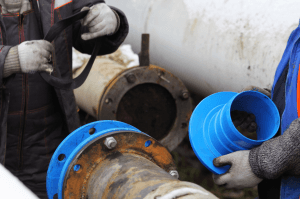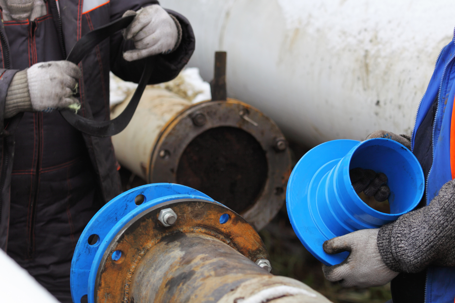Aging or damaged pipelines can disrupt essential services and lead to costly, invasive repairs. Traditional pipe repair methods often require extensive digging, causing further inconvenience and expense.
Cured-in-place pipe Lining (CIPP) is a modern, efficient solution for pipeline repair. It uses a trenchless technique in which a resin-saturated liner is inserted into the damaged pipe and cured to form a new pipe within the old one.
This method provides a durable repair, extending the pipeline’s lifespan by decades without significantly reducing its capacity, unlike traditional slip-lining methods. CIPP particularly benefits municipal authorities and facility managers who require quick and effective pipeline repairs with minimal disruption.
This guide will explore cured-in-place pipe lining in detail, covering its process, benefits, comparison with traditional methods like slip lining, and its suitability for various users. Learn how CIPP can be a cost-effective solution for your pipeline issues.

What is Cured-In-Place Pipe Lining?
Cured-in-place pipe lining (CIPP) is a trenchless pipe repair method for rehabilitating existing pipelines. It is cost-effective because it minimizes the need for excavation, reducing disruption to the surrounding area.
This method is used to repair pipes that carry sewage, water, and industrial fluids. It effectively seals leaks and prevents root intrusion without the need for extensive digging.
Process of CIPP Lining
The CIPP lining process begins with a thorough cleaning and inspection of the existing pipeline to ensure it is free of debris and that damage is accurately assessed. Next, the resin-saturated liner is inserted into the pipeline. This liner is usually made from a flexible, textile-reinforced material that can easily adapt to the shape of the original pipe.
Once the liner is in place, it is expanded to fit tightly against the interior walls of the old pipe and then cured. Curing can be done using hot water, steam, or ultraviolet light, depending on the resin type.
The heat or UV light triggers a chemical reaction in the resin. This causes it to harden and bond to the pipe interior, creating a smooth and durable new pipe surface.
Another trenchless repair option is the pipe bursting method. This method involves breaking the existing pipe while simultaneously pulling a new pipe into place. Both CIPP and pipe bursting offer less invasive solutions compared to traditional excavation.
Benefits of Cured-In-Place Pipe Lining
Cured-In-Place Pipe (CIPP) lining is known for its long-lasting performance, making it a reliable choice for fixing pipes. This method can extend the life of a pipeline for up to 50 years.
Their durability comes from the high-quality materials used in their construction and their installation methods. Here are some features that contribute to their longevity:
Withstanding Environmental Challenges
CIPP is excellent at handling environmental challenges like changes in weather or unstable soil conditions. It’s tough against UV rays and temperature shifts, ensuring it doesn’t break down easily over time, even if it gets exposed to sunlight occasionally due to soil movements.
Chemical and Corrosion Resistance
CIPP stands up well against chemicals and doesn’t corrode easily. The liners are usually made from epoxy or vinyl ester-based resins, which are chosen specifically because they can handle harsh substances.
This feature particularly benefits industrial pipes that might carry chemicals or other corrosive materials.
Reinforcing Pipe Strength
CIPP also adds strength to the old pipes it lines. Once the liner is cured, it behaves like a new pipe inside the old one, not only fixing leaks and blocking roots from entering. Aside from that, it also improves the pipe’s ability to withstand pressure.
This added strength is especially important in places like cities or under roads, where pipes experience much external pressure.
Cured-In-Place Pipe vs. Slip Lining
CIPP and slip lining are popular methods for repairing aging or damaged pipes without excavating extensively. While they share some similarities in their approach to minimally invasive pipe repairs, there are some differences, such as in their:
Installation Process
CIPP involves inserting a resin-saturated felt tube into the existing pipe, which is then expanded and cured to form a tight, seamless new pipe within the old one. This process is done in situ and can be activated by heat, UV light, or ambient curing methods.
In contrast, slip lining involves inserting a new, smaller pipe into the damaged one and then filling the space between the old and new pipes with grouting material. Slip lining is simpler but reduces the internal diameter of the original pipe.
Impact on Pipe Diameter
One of the main differences between CIPP and slip lining is the impact on the pipe’s internal diameter. CIPP virtually leaves the diameter unchanged as the liner conforms closely to the original pipe’s interior. Slip lining, however, reduces the diameter since a new pipe is installed within the existing one. This may not be ideal for pipes that require maximum flow capacity.
Durability and Strength
CIPP generally offers better durability and structural strength compared to slip lining. The CIPP process creates a pipe within a pipe that is resistant to corrosion, leaks, and root intrusion. It essentially provides a new lifespan to the existing pipeline.
Slip lining also increases the pipe’s lifespan but might not be as robust as CIPP because it relies on the old pipe for structural integrity. The new pipe mainly serves as a conduit.
Who Should Use Cured-In-Place Pipe Lining?
Overall, CIPP lining is a versatile repair solution suitable for various users who need efficient, less disruptive methods to fix or strengthen their piping systems.
Some groups that can benefit from using CIPP include:
- Municipalities and Cities: Urban areas with extensive underground piping systems often face challenges such as traffic disruptions and high repair costs when fixing sewer and water pipes. CIPP is ideal because it minimizes surface disruption and can be completed quickly compared to traditional excavation methods.
- Industrial Facilities: Plants and factories that use pipes to transport chemicals or waste products benefit from CIPP’s chemical resistance properties. The method is also suitable for situations where downtime needs to be minimized.
- Residential Property Owners: Homeowners with aging sewer systems can use CIPP to extend the life of their pipes without digging up their yards. This is especially beneficial for properties with extensive landscaping or hardscaping.
- Commercial Property Managers: Office buildings, shopping centers, and other commercial properties benefit from the quick and clean CIPP installation process. This method is ideal for environments that cannot afford significant disruptions or visible construction activities.
- Environmental Managers: For those concerned with environmental conservation, CIPP offers a less invasive option that reduces the risk of contaminating nearby soil or water sources during pipe repairs.

